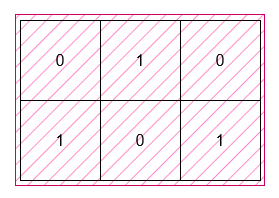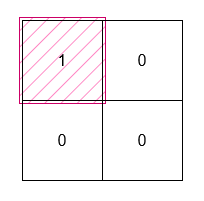| comments | difficulty | edit_url | rating | source | tags | ||
|---|---|---|---|---|---|---|---|
true |
Medium |
1348 |
Weekly Contest 403 Q2 |
|
You are given a 2D binary array grid. Find a rectangle with horizontal and vertical sides with the smallest area, such that all the 1's in grid lie inside this rectangle.
Return the minimum possible area of the rectangle.
Example 1:
Input: grid = [[0,1,0],[1,0,1]]
Output: 6
Explanation:
The smallest rectangle has a height of 2 and a width of 3, so it has an area of 2 * 3 = 6.
Example 2:
Input: grid = [[1,0],[0,0]]
Output: 1
Explanation:
The smallest rectangle has both height and width 1, so its area is 1 * 1 = 1.
Constraints:
1 <= grid.length, grid[i].length <= 1000grid[i][j]is either 0 or 1.- The input is generated such that there is at least one 1 in
grid.
We can traverse grid, finding the minimum boundary of all 1s, denoted as
The time complexity is grid, respectively. The space complexity is
class Solution:
def minimumArea(self, grid: List[List[int]]) -> int:
x1 = y1 = inf
x2 = y2 = -inf
for i, row in enumerate(grid):
for j, x in enumerate(row):
if x == 1:
x1 = min(x1, i)
y1 = min(y1, j)
x2 = max(x2, i)
y2 = max(y2, j)
return (x2 - x1 + 1) * (y2 - y1 + 1)class Solution {
public int minimumArea(int[][] grid) {
int m = grid.length, n = grid[0].length;
int x1 = m, y1 = n;
int x2 = 0, y2 = 0;
for (int i = 0; i < m; ++i) {
for (int j = 0; j < n; ++j) {
if (grid[i][j] == 1) {
x1 = Math.min(x1, i);
y1 = Math.min(y1, j);
x2 = Math.max(x2, i);
y2 = Math.max(y2, j);
}
}
}
return (x2 - x1 + 1) * (y2 - y1 + 1);
}
}class Solution {
public:
int minimumArea(vector<vector<int>>& grid) {
int m = grid.size(), n = grid[0].size();
int x1 = m, y1 = n;
int x2 = 0, y2 = 0;
for (int i = 0; i < m; ++i) {
for (int j = 0; j < n; ++j) {
if (grid[i][j] == 1) {
x1 = min(x1, i);
y1 = min(y1, j);
x2 = max(x2, i);
y2 = max(y2, j);
}
}
}
return (x2 - x1 + 1) * (y2 - y1 + 1);
}
};func minimumArea(grid [][]int) int {
x1, y1 := len(grid), len(grid[0])
x2, y2 := 0, 0
for i, row := range grid {
for j, x := range row {
if x == 1 {
x1, y1 = min(x1, i), min(y1, j)
x2, y2 = max(x2, i), max(y2, j)
}
}
}
return (x2 - x1 + 1) * (y2 - y1 + 1)
}function minimumArea(grid: number[][]): number {
const [m, n] = [grid.length, grid[0].length];
let [x1, y1] = [m, n];
let [x2, y2] = [0, 0];
for (let i = 0; i < m; ++i) {
for (let j = 0; j < n; ++j) {
if (grid[i][j] === 1) {
x1 = Math.min(x1, i);
y1 = Math.min(y1, j);
x2 = Math.max(x2, i);
y2 = Math.max(y2, j);
}
}
}
return (x2 - x1 + 1) * (y2 - y1 + 1);
}
